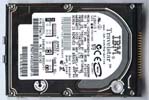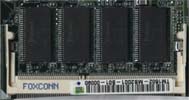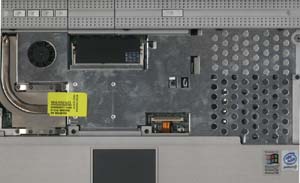On the chipset side, the T9 makes use of Intel's 815EM which is the mobile version of the popular 815 desktop chipset. The chipset features both integrated video via an integrated Intel 815 AGP 4X graphic part as well as integrated audio thanks to an integrated Intel 82801BA AC97 controller. The 815 graphics chip supports 2D as well as basic 3D applications and uses system memory as video buffer. Like other integrated video solutions without a display cache, the 815EM chipset is constantly sending video information over the already crowded system bus, resulting in a system-wide bottleneck. This, however, is a limitation of using the integrated video on the 815EM and not a limitation of the ASUS T9 in any way. The chipset also provides support for the 2 USB ports found on the laptop.
The Intel 815 graphics chip powers a 14.1" active matrix XGA (1024x768) TFT panel. The screen proved to be impressive, with sharp text and a bright display. Although the graphics part is able to output at up to 1600x1200, it can only do so at 8 bit color. Going to 16 bit color provides a maximum resolution of 1600x900 while the maximum color depth of 24 bit color results in a maximum resolution of 1280x1024. Since the panel resolution is capped at 1024x768, we found ourselves using the laptop at 1024x768x24. When hooked up to an external monitor, the max we would set the resolution to was 1280x1024 since going any higher would result in less color depth. It is rare to find laptop displays that provide support for resolutions over 1024x768 since increasing the maximum resolution of the panel is often costly. Video output is provided by the 815's Video Controller Hub which provides a direct connection to the TFT panel.
Hard drive wise, our ASUS T9 came outfitted with a 30GB IBM Travelstar hard drive. The drive is a 30GN series drive which features a rotation speed of 4200 RPM and an average seek time of 12.0ms. Although the drive is not too slow in relation to other notebook drives (with exception to IBM's newly announced 5400 RPM drives), a notebook hard drive is typically a major bottleneck in all laptops.
The ASUS T9 that we got came outfitted with 128MB of memory mounted directly on the motherboard and one free SODIMM socket. This socket can accept up to an additional 256MB of PC100 memory for a total of 384MB of system memory.
For sound the ASUS T9 uses two speakers mounted in the front panel of the laptop on the left and right sides. The speakers produced a rather tinny sound, typical of what we have come to expect from notebook sound setups. There is really only so much sound that can come out of two speakers not much larger than a penny.
Power for the notebook is provided by a 6 cell Lithium Ion battery which puts out 3600mAh and 40W.
One thing we left out was how easy it was to get to all the vital components on the ASUS T9. Changing out the laptop hard drive required only the removal of one large screw. Once out, a panel covering the hard drive easily popped open revealing the IBM hard drive which can easily be swapped out and replaced.
Getting to the SODIMM slot and the CPU proved to be just as painless. Although the two items are located in the heart of the system, they are easily accessed by popping out the T9's keyboard. The keyboard is held onto the laptop via 4 clips located along the top row of the keyboard. By pressing the clips in with a small flathead screwdriver, the keyboard snaps out of place and exposes both the SODIMM slot as well as the CPU.
The design of the ASUS T9 is extremely conducive to upgrades. As far as accessibility to vital components goes, the T9 is among the best we have seen as even the typically most daunting notebook upgrade task, upgrading a CPU, can be performed in minutes with a simple screwdriver.
There is a limit to how far you can upgrade the CPU to, however. Like some desktop systems, the BIOS and the motherboard on the T9 can only support one type of CPU: the 0.18 micron Mobile Pentium III chip. As of now the maxium speed that the Mobile Pentium III is offered in is 1.0GHz. We can't be sure how far Intel will take the Mobile Pentium III line, as it was recently replaced by the 0.13 micron Mobile Pentium III-M processors. It is unlikely that Mobile Pentium III chips will advance past the 1.0GHz mark, but at least the T9 does provide a CPU upgrade option if Intel does make more chips available.















0 Comments
View All Comments